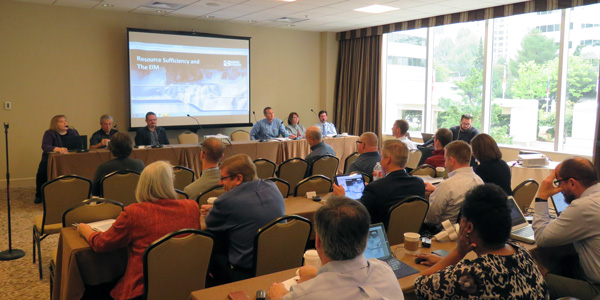By Jason Fordney
SEATTLE — Western Energy Imbalance Market (EIM) resource sufficiency tests are generally working, but fluctuating load forecasts are a major challenge in passing the tests, market participants said in a regional forum Thursday.
Participants in CAISO’s regional EIM market must pass a series of resource sufficiency tests, including a balancing test for energy, a capacity test and a flexibility ramping test. Market participants discussed possible enhancements at the Regional Issues Forum held in conjunction with the EIM Governing Body meeting the day before.
The forum meets three times a year and includes 10 representatives from various sectors who discuss topics outside of the normal ISO stakeholder process. The sectors include transmission-owning utilities; power producers and power marketers; public interest groups; publicly owned utilities; and neighboring balancing authorities.
The EIM is integrated with CAISO’s market but only includes the ISO’s real-time functionality and not that for the day-ahead market. The sufficiency test is one of a series of processes meant to ensure that EIM entities have sufficient generation to supply the real-time market in the absence of providing day-ahead schedules. (See CAISO: Don’t Lean on EIM for Capacity.) The ISO performs the test ahead of the market run for each operating hour.
While the general structure of the resource sufficiency framework is sound, it could be enhanced, said Powerex trading manager Mike Goodenough. Powerex does not yet participate in the EIM but is slated to join next April. FERC on Thursday approved the company’s implementation agreement for joining the market, which was first conditionally approved by FERC staff in August. (See Wary FERC Approval for Powerex EIM Agreement.)
Goodenough said the level of required resource sufficiency should not be changed because different balancing authority areas (BAAs) have different capacity and flexibility challenges. Raising the requirement might increase costs for entities that don’t have surplus capacity, and decreasing it might reduce flexibility costs but remove opportunities to sell capacity and energy.
The workability of the program could be improved, and “we think we should work toward getting more transparency and metrics around those tests,” Goodenough said.
Possible improvements include adjusting the timelines of the tests so entities know their specific requirements and can obtain needed capacity or flexibility. There are questions as to whether some BAAs are failing in hours when they should have passed, and others are passing when they should have failed, he said. He suggested more granular data from CAISO and historic analysis by the Department of Market Monitoring on whether the required quantities have been consistent with demand and imbalance requirements in BAAs.
Arizona Public Service’s EIM project manager Moe Sakkijha said his utility worked with CAISO to address the fact that the ISO’s load forecasts can fluctuate up to 300 MW. APS in June also began providing the ISO with hourly load forecasts to assist in modeling. CAISO has agreed to freeze the load forecast to help with the resulting uneconomic dispatch, Sakkijha said, but he is not sure when the ISO plans to implement the change.
“A very important issue for the EIM entities was freezing of the load forecast,” he said. APS is also bidding solar and wind resources into the EIM to improve the results for the sufficiency tests for capacity, balancing and flexibility. The company is working with some utility scale solar sources to be able to automatically respond.
Kathy Anderson, Idaho Power system operations leader, said that her company has not begun participating in the EIM but already has some concerns. (See Idaho Power Inks Agreement to Join Western EIM.)
“A lot of conversations with the entities that are live [in the EIM] give me some concerns, especially when we start talking the moving target of the load, and chasing that,” she said. Idaho Power has hydro, wind, natural gas and coal, but a lot of EIM resources will be non-run-of-river hydro.
Idaho Power also plans to have one coal plant and some natural gas participate in the EIM, but not its wind and solar. The hundreds of megawatts of wind and solar in its BAA under Public Utility Regulatory Policies Act contracts can only be dispatched for reliability. Hydro flexibility limitations because of fish protection requirements and other regulations at its 1,400-MW Hells Canyon facility will be one challenge in passing resource sufficiency tests, and the plant is also affected by seasonal challenges, and regulations.
The changing load forecast is a big issue, she said, and “it is hard enough to be a balancing authority without continually chasing a number just to pass the test,” she said.





